All Exams >
NEET >
Biology Class 12 >
All Questions
All questions of Reproduction in Organisms for NEET Exam
Oestrous cycle is reported in- a)Cows and sheep
- b)Humans and monkeys
- c)Chimpanzees and gorillas
- d)None of these
Correct answer is option 'A'. Can you explain this answer?
Oestrous cycle is reported in
a)
Cows and sheep
b)
Humans and monkeys
c)
Chimpanzees and gorillas
d)
None of these
|
|
Partho Khanna answered |
Oestrous cycle in cows and sheep:
The oestrous cycle is the reproductive cycle in female mammals, including cows and sheep. It is also known as the estrous cycle or heat cycle. Here is a detailed explanation of the oestrous cycle in cows and sheep:
Definition: The oestrous cycle is a series of physiological changes that occur in the female reproductive system, preparing it for pregnancy.
Duration: The oestrous cycle in cows lasts for about 21 days, while in sheep, it lasts for about 17 days.
Phases: The oestrous cycle can be divided into four phases - proestrus, oestrus, metestrus, and diestrus.
1. Proestrus: This phase lasts for 2-3 days, during which the follicles in the ovaries start to grow, and estrogen levels begin to rise.
2. Oestrus: This is the most critical phase, lasting for 12-18 hours in cows and 24-36 hours in sheep. The female shows signs of sexual receptivity and actively seeks out a mate.
3. Metestrus: This phase lasts for 2-3 days, during which the corpus luteum is formed in the ovary, and progesterone levels begin to rise.
4. Diestrus: This phase lasts for about 14-16 days in cows and 11-14 days in sheep. During this phase, the corpus luteum produces high levels of progesterone, preparing the uterus for pregnancy.
Conclusion: The oestrous cycle is essential for the reproduction of cows and sheep. Understanding the different phases of the oestrous cycle can help farmers and veterinarians in managing the reproductive health of their herds.
The oestrous cycle is the reproductive cycle in female mammals, including cows and sheep. It is also known as the estrous cycle or heat cycle. Here is a detailed explanation of the oestrous cycle in cows and sheep:
Definition: The oestrous cycle is a series of physiological changes that occur in the female reproductive system, preparing it for pregnancy.
Duration: The oestrous cycle in cows lasts for about 21 days, while in sheep, it lasts for about 17 days.
Phases: The oestrous cycle can be divided into four phases - proestrus, oestrus, metestrus, and diestrus.
1. Proestrus: This phase lasts for 2-3 days, during which the follicles in the ovaries start to grow, and estrogen levels begin to rise.
2. Oestrus: This is the most critical phase, lasting for 12-18 hours in cows and 24-36 hours in sheep. The female shows signs of sexual receptivity and actively seeks out a mate.
3. Metestrus: This phase lasts for 2-3 days, during which the corpus luteum is formed in the ovary, and progesterone levels begin to rise.
4. Diestrus: This phase lasts for about 14-16 days in cows and 11-14 days in sheep. During this phase, the corpus luteum produces high levels of progesterone, preparing the uterus for pregnancy.
Conclusion: The oestrous cycle is essential for the reproduction of cows and sheep. Understanding the different phases of the oestrous cycle can help farmers and veterinarians in managing the reproductive health of their herds.
Read the following statements about 'Terror of Bengal' and select the correct ones.
(i) Terror of Bengal' is the name given to water hyacinth (Eichhornia), an algae.
(ii) Eichhornia was introduced in India due to its aesthetic value.
(iii) Eichhornia drains oxygen from the water which leads to death of fishes.- a)(i) and (ii)
- b)(i) and (iii)
- c)(ii) and (iii)
- d)(i), (ii) and (iii)
Correct answer is option 'C'. Can you explain this answer?
Read the following statements about 'Terror of Bengal' and select the correct ones.
(i) Terror of Bengal' is the name given to water hyacinth (Eichhornia), an algae.
(ii) Eichhornia was introduced in India due to its aesthetic value.
(iii) Eichhornia drains oxygen from the water which leads to death of fishes.
(i) Terror of Bengal' is the name given to water hyacinth (Eichhornia), an algae.
(ii) Eichhornia was introduced in India due to its aesthetic value.
(iii) Eichhornia drains oxygen from the water which leads to death of fishes.
a)
(i) and (ii)
b)
(i) and (iii)
c)
(ii) and (iii)
d)
(i), (ii) and (iii)
|
|
Nishanth Saini answered |
Terror of Bengal refers to water hyacinth (Eichhornia), an aquatic plant species. It is a serious problem in water bodies as it grows rapidly and disrupts the ecosystem. The following statements are given about Terror of Bengal:
(i) False: Terror of Bengal is not an algae but a water plant species called water hyacinth (Eichhornia).
(ii) True: Eichhornia was introduced in India as an ornamental plant due to its beautiful purple flowers.
(iii) True: Eichhornia drains oxygen from the water which can lead to the death of fishes and other aquatic organisms.
Therefore, option (C) is the correct answer as it includes the two correct statements about Eichhornia.
(i) False: Terror of Bengal is not an algae but a water plant species called water hyacinth (Eichhornia).
(ii) True: Eichhornia was introduced in India as an ornamental plant due to its beautiful purple flowers.
(iii) True: Eichhornia drains oxygen from the water which can lead to the death of fishes and other aquatic organisms.
Therefore, option (C) is the correct answer as it includes the two correct statements about Eichhornia.
Vegetative propagation is the term used for- a)sexual reproduction in animals
- b)sexual reproduction in plants
- c)asexual reproduction in animals
- d)asexual reproduction in plants
Correct answer is option 'D'. Can you explain this answer?
Vegetative propagation is the term used for
a)
sexual reproduction in animals
b)
sexual reproduction in plants
c)
asexual reproduction in animals
d)
asexual reproduction in plants
|
|
Sai Mehta answered |
Vegetative Propagation in Plants
Vegetative propagation is a type of asexual reproduction in plants where new plants are produced from vegetative parts of the parent plant, i.e., roots, stems, and leaves. The new plants produced are genetically identical to the parent plant. This method of reproduction is commonly used for commercial production of crops and horticultural plants.
Types of Vegetative Propagation
There are several types of vegetative propagation:
1. Stem Cuttings - A stem cutting is a piece of stem that is cut from the parent plant and rooted to produce a new plant.
2. Leaf Cuttings - Leaf cuttings involve taking a leaf from the parent plant and rooting it to produce a new plant.
3. Root Cuttings - Root cuttings involve taking a piece of root from the parent plant and rooting it to produce a new plant.
4. Runners - Runners are specialized stems that grow along the ground and produce new plants at nodes.
5. Suckers - Suckers are shoots that arise from the root system of a plant and grow into new plants.
6. Bulbs - Bulbs are specialized underground structures that contain a complete miniature plant and are capable of producing new plants.
Advantages of Vegetative Propagation
1. The new plants produced are genetically identical to the parent plant, ensuring that desirable characteristics are retained.
2. The new plants produced are ready to flower or fruit earlier than plants produced from seeds.
3. The process is quicker and more efficient than sexual reproduction.
4. It allows for the propagation of plants that do not produce viable seeds.
Disadvantages of Vegetative Propagation
1. The lack of genetic diversity can make plants more susceptible to diseases and pests.
2. The cost of producing new plants can be higher than producing plants from seeds.
In conclusion, vegetative propagation is an important method of plant reproduction used for commercial production of crops and horticultural plants. It has its advantages and disadvantages, and the choice of propagation method depends on various factors, including cost, time, and the desired characteristics of the new plants produced.
Vegetative propagation is a type of asexual reproduction in plants where new plants are produced from vegetative parts of the parent plant, i.e., roots, stems, and leaves. The new plants produced are genetically identical to the parent plant. This method of reproduction is commonly used for commercial production of crops and horticultural plants.
Types of Vegetative Propagation
There are several types of vegetative propagation:
1. Stem Cuttings - A stem cutting is a piece of stem that is cut from the parent plant and rooted to produce a new plant.
2. Leaf Cuttings - Leaf cuttings involve taking a leaf from the parent plant and rooting it to produce a new plant.
3. Root Cuttings - Root cuttings involve taking a piece of root from the parent plant and rooting it to produce a new plant.
4. Runners - Runners are specialized stems that grow along the ground and produce new plants at nodes.
5. Suckers - Suckers are shoots that arise from the root system of a plant and grow into new plants.
6. Bulbs - Bulbs are specialized underground structures that contain a complete miniature plant and are capable of producing new plants.
Advantages of Vegetative Propagation
1. The new plants produced are genetically identical to the parent plant, ensuring that desirable characteristics are retained.
2. The new plants produced are ready to flower or fruit earlier than plants produced from seeds.
3. The process is quicker and more efficient than sexual reproduction.
4. It allows for the propagation of plants that do not produce viable seeds.
Disadvantages of Vegetative Propagation
1. The lack of genetic diversity can make plants more susceptible to diseases and pests.
2. The cost of producing new plants can be higher than producing plants from seeds.
In conclusion, vegetative propagation is an important method of plant reproduction used for commercial production of crops and horticultural plants. It has its advantages and disadvantages, and the choice of propagation method depends on various factors, including cost, time, and the desired characteristics of the new plants produced.
Which of the following options shows bisexual animals only? - a)Amoeba, sponge, leech
- b)Sponge, cockroach, Amoeba
- c)Earthworm, sponge, leech
- d)Tapeworm, earthworm, honey bee
Correct answer is option 'C'. Can you explain this answer?
Which of the following options shows bisexual animals only?
a)
Amoeba, sponge, leech
b)
Sponge, cockroach, Amoeba
c)
Earthworm, sponge, leech
d)
Tapeworm, earthworm, honey bee
|
|
Mira Joshi answered |
When both male and female sex organs are present in the same individual, such animals are called hermaphrodite, monoecious or bisexual, e.g., tapeworm, earthworm and leech.
In maize, a meiocyte has 20 chromos. What will be the number of chromosomes in its somatic cell ? - a)40
- b)30
- c)20
- d)10
Correct answer is option 'C'. Can you explain this answer?
In maize, a meiocyte has 20 chromos. What will be the number of chromosomes in its somatic cell ?
a)
40
b)
30
c)
20
d)
10
|
|
Mira Joshi answered |
The germinal cells are diploid and act as meiocytes,which undergo meiosis to produce haploid gametes. Thus, meiocytes have diploid (2n) number of chromosomes, same as the somatic cells.
Which of the following options shows two plants in which new plantlets arise from the same organ?- a)Dahlia and ginger
- b)Potato and sweet potato
- c)Dahlia and rose
- d)Potato and sugarcane
Correct answer is option 'D'. Can you explain this answer?
Which of the following options shows two plants in which new plantlets arise from the same organ?
a)
Dahlia and ginger
b)
Potato and sweet potato
c)
Dahlia and rose
d)
Potato and sugarcane
|
|
Anu Sengupta answered |
Answer:
Introduction:
Plants are capable of reproducing through various modes such as vegetative propagation, sexual reproduction, etc. In vegetative propagation, new plants arise from the vegetative parts of the plant such as stem, leaves, roots, etc. In some plants, new plantlets arise from the same organ. In this question, we need to identify such plants from the given options.
Option D: Potato and Sugarcane
Both potato and sugarcane are examples of plants in which new plantlets arise from the same organ. Let's discuss each of them in detail.
Potato:
Potato is a tuberous crop that reproduces vegetatively through the underground stem or tuber. The tuber of the potato plant contains buds or eyes that are capable of developing into new plants. When these tubers are planted in the soil, the buds start growing and give rise to new potato plants. Thus, new plantlets arise from the same organ, i.e., the tuber.
Sugarcane:
Sugarcane is a perennial crop that reproduces vegetatively through the stem. The stem of the sugarcane plant is called the cane, which contains nodes and internodes. The nodes are the points on the stem where the leaves emerge, and the internodes are the spaces between the nodes. Each node of the sugarcane plant has a bud that is capable of developing into a new plant. When a sugarcane stalk is planted in the soil, the buds on the nodes start growing and give rise to a new sugarcane plant. Thus, new plantlets arise from the same organ, i.e., the stem.
Conclusion:
From the given options, potato and sugarcane are the two plants in which new plantlets arise from the same organ.
Introduction:
Plants are capable of reproducing through various modes such as vegetative propagation, sexual reproduction, etc. In vegetative propagation, new plants arise from the vegetative parts of the plant such as stem, leaves, roots, etc. In some plants, new plantlets arise from the same organ. In this question, we need to identify such plants from the given options.
Option D: Potato and Sugarcane
Both potato and sugarcane are examples of plants in which new plantlets arise from the same organ. Let's discuss each of them in detail.
Potato:
Potato is a tuberous crop that reproduces vegetatively through the underground stem or tuber. The tuber of the potato plant contains buds or eyes that are capable of developing into new plants. When these tubers are planted in the soil, the buds start growing and give rise to new potato plants. Thus, new plantlets arise from the same organ, i.e., the tuber.
Sugarcane:
Sugarcane is a perennial crop that reproduces vegetatively through the stem. The stem of the sugarcane plant is called the cane, which contains nodes and internodes. The nodes are the points on the stem where the leaves emerge, and the internodes are the spaces between the nodes. Each node of the sugarcane plant has a bud that is capable of developing into a new plant. When a sugarcane stalk is planted in the soil, the buds on the nodes start growing and give rise to a new sugarcane plant. Thus, new plantlets arise from the same organ, i.e., the stem.
Conclusion:
From the given options, potato and sugarcane are the two plants in which new plantlets arise from the same organ.
It is a common method of vegetative propagation in which 20 - 30 cm long pieces of one year old stems are cut, their lower ends are dipped in root promoting hormones and are then planted in the soil, which then develop adventitious roots. This method of vegetative propagation is performed in
- a)Begonia and Bryophyllum
- b)Lemon and Orange
- c)Rose and Sugarcane
- d)All of these
Correct answer is option 'A'. Can you explain this answer?
It is a common method of vegetative propagation in which 20 - 30 cm long pieces of one year old stems are cut, their lower ends are dipped in root promoting hormones and are then planted in the soil, which then develop adventitious roots. This method of vegetative propagation is performed in
a)
Begonia and Bryophyllum
b)
Lemon and Orange
c)
Rose and Sugarcane
d)
All of these
|
|
Lakshmi Pillai answered |
Vegetative propagation is a process of asexual reproduction in plants, in which new plants are produced from vegetative parts such as roots, stems, and leaves. One of the common methods of vegetative propagation is stem cutting.
Stem cutting involves taking cuttings of stems from a parent plant and planting them in soil to develop new plants. The stem cuttings are usually taken from one year old stems, which are about 20-30 cm long. This method is performed by following the steps given below:
1. Select a healthy parent plant: The parent plant should be healthy and free from diseases.
2. Choose the right time: The best time to take stem cuttings is during the growing season when the plant is actively growing.
3. Prepare the stem cuttings: Cut the stem with a sharp and clean knife or scissors. The stem should be about 20-30 cm long and have at least three nodes.
4. Remove the leaves: Remove the leaves from the lower half of the stem.
5. Dip the stem cuttings in rooting hormone powder: This will promote the development of adventitious roots.
6. Plant the stem cuttings: Plant the stem cuttings in a well-draining soil mix. Water the soil and cover the container with a plastic bag to increase humidity.
7. Wait for the roots to develop: Keep the soil moist and wait for the roots to develop. Once the roots have developed, the new plant can be transplanted to a larger pot or planted in the ground.
Stem cutting is a common method of vegetative propagation in many plants, including:
- Lemon and Orange
- Begonia and Bryophyllum
- Rose and Sugarcane
Therefore, the correct answer is option 'A'.
Stem cutting involves taking cuttings of stems from a parent plant and planting them in soil to develop new plants. The stem cuttings are usually taken from one year old stems, which are about 20-30 cm long. This method is performed by following the steps given below:
1. Select a healthy parent plant: The parent plant should be healthy and free from diseases.
2. Choose the right time: The best time to take stem cuttings is during the growing season when the plant is actively growing.
3. Prepare the stem cuttings: Cut the stem with a sharp and clean knife or scissors. The stem should be about 20-30 cm long and have at least three nodes.
4. Remove the leaves: Remove the leaves from the lower half of the stem.
5. Dip the stem cuttings in rooting hormone powder: This will promote the development of adventitious roots.
6. Plant the stem cuttings: Plant the stem cuttings in a well-draining soil mix. Water the soil and cover the container with a plastic bag to increase humidity.
7. Wait for the roots to develop: Keep the soil moist and wait for the roots to develop. Once the roots have developed, the new plant can be transplanted to a larger pot or planted in the ground.
Stem cutting is a common method of vegetative propagation in many plants, including:
- Lemon and Orange
- Begonia and Bryophyllum
- Rose and Sugarcane
Therefore, the correct answer is option 'A'.
Which one of the following processes results in the formation of a clone of bacteria?- a)Transformation
- b)Transduction
- c)Binary fission
- d)Conjugation
Correct answer is option 'C'. Can you explain this answer?
Which one of the following processes results in the formation of a clone of bacteria?
a)
Transformation
b)
Transduction
c)
Binary fission
d)
Conjugation
|
|
Geetika Shah answered |
In binary fission, the parent organism divides into two halves, each half forming an independent daughters organism. Binary fission involves mitosis. The resultant offspring are genetically identical to the parent and to each other.
The changes that indicate reproductive maturity in humans include- a)growth of pubic hair
- b)changes in skeleton
- c)weight gain
- d)(a) and (b)
Correct answer is option 'D'. Can you explain this answer?
The changes that indicate reproductive maturity in humans include
a)
growth of pubic hair
b)
changes in skeleton
c)
weight gain
d)
(a) and (b)
|
|
Mira Joshi answered |
Reproductive organs develop and mature during puberty. Changes that indicate reproductive maturity are development of external genitalia, breasts, body hair, pubic hair, changes in skeleton, etc
Strobilanthus Kunthiana differs from bamboo in- a)being monocarpic
- b)length of juvenile phase
- c)being polycarpic
- d)none of these
Correct answer is option 'B'. Can you explain this answer?
Strobilanthus Kunthiana differs from bamboo in
a)
being monocarpic
b)
length of juvenile phase
c)
being polycarpic
d)
none of these
|
|
Mira Joshi answered |
Strobilanthus kunthiana (Neelakuranji) flower once in 12 years, its juvenile phase is very long. The last time this plant flowered was during September - October 2006. It is found in hilly areas of Kerala, Karnataka and Tamil Nadu and attract a large number of tourists.
Which of the following statements is incorrect?- a)Earthworms and leeches are hermaphrodite animals
- b)Young ones of animals which have external fertilization receive little or no-parental care.
- c)If the egg is not fertilized, it is thrown out of the body along with the lining of the uterus as menstrual flow.
- d)Sex organs in human beings are formed at puberty
Correct answer is option 'D'. Can you explain this answer?
Which of the following statements is incorrect?
a)
Earthworms and leeches are hermaphrodite animals
b)
Young ones of animals which have external fertilization receive little or no-parental care.
c)
If the egg is not fertilized, it is thrown out of the body along with the lining of the uterus as menstrual flow.
d)
Sex organs in human beings are formed at puberty
|
|
Mira Joshi answered |
Sex organs in human are formed before birth (during embryonic development).
Sexual reproduction is considered more beneficial than asexual reproduction because- a)it is not affected by adverse environmental conditions
- b)fertilisation is a chance factor
- c)it rapidly multiplies the population
- d)it assists in evolution by producing variations.
Correct answer is option 'D'. Can you explain this answer?
Sexual reproduction is considered more beneficial than asexual reproduction because
a)
it is not affected by adverse environmental conditions
b)
fertilisation is a chance factor
c)
it rapidly multiplies the population
d)
it assists in evolution by producing variations.
|
|
Uday Dasgupta answered |
Benefits of Sexual Reproduction over Asexual Reproduction
Sexual reproduction is a process of reproduction that involves the fusion of two gametes to form a zygote. It is considered more beneficial than asexual reproduction due to the following reasons:
1. Genetic Diversity: Sexual reproduction leads to genetic diversity as the offspring inherit half of their genetic material from each parent. This results in the formation of unique combinations of genes, which leads to variations within a population. These variations can be useful in adapting to changing environmental conditions and in the evolution of new species.
2. Elimination of Harmful Mutations: Sexual reproduction helps in eliminating harmful mutations from the population. During the formation of gametes, the process of meiosis helps in shuffling the genetic material, which leads to the elimination of harmful mutations.
3. Adaptation to Changing Environments: Sexual reproduction allows for the adaptation to changing environments. As mentioned earlier, genetic diversity leads to variations within a population. These variations can help in adapting to changing environmental conditions, such as climate change or the emergence of new pathogens.
4. Reduces the Risk of Extinction: Sexual reproduction reduces the risk of extinction. Asexual reproduction leads to the formation of genetically identical offspring, which means that if one individual is susceptible to a disease or environmental change, the entire population is at risk. Sexual reproduction, on the other hand, produces genetically diverse offspring, which reduces the risk of extinction.
Conclusion
In conclusion, sexual reproduction is considered more beneficial than asexual reproduction due to its ability to produce genetic diversity, eliminate harmful mutations, adapt to changing environments, and reduce the risk of extinction. These benefits have played a crucial role in the evolution of new species and the survival of existing ones.
Sexual reproduction is a process of reproduction that involves the fusion of two gametes to form a zygote. It is considered more beneficial than asexual reproduction due to the following reasons:
1. Genetic Diversity: Sexual reproduction leads to genetic diversity as the offspring inherit half of their genetic material from each parent. This results in the formation of unique combinations of genes, which leads to variations within a population. These variations can be useful in adapting to changing environmental conditions and in the evolution of new species.
2. Elimination of Harmful Mutations: Sexual reproduction helps in eliminating harmful mutations from the population. During the formation of gametes, the process of meiosis helps in shuffling the genetic material, which leads to the elimination of harmful mutations.
3. Adaptation to Changing Environments: Sexual reproduction allows for the adaptation to changing environments. As mentioned earlier, genetic diversity leads to variations within a population. These variations can help in adapting to changing environmental conditions, such as climate change or the emergence of new pathogens.
4. Reduces the Risk of Extinction: Sexual reproduction reduces the risk of extinction. Asexual reproduction leads to the formation of genetically identical offspring, which means that if one individual is susceptible to a disease or environmental change, the entire population is at risk. Sexual reproduction, on the other hand, produces genetically diverse offspring, which reduces the risk of extinction.
Conclusion
In conclusion, sexual reproduction is considered more beneficial than asexual reproduction due to its ability to produce genetic diversity, eliminate harmful mutations, adapt to changing environments, and reduce the risk of extinction. These benefits have played a crucial role in the evolution of new species and the survival of existing ones.
Which of the following statements is not correct regarding sexuality in organisms?- a)When both male and female flowers are present on the same plant, the condition is said to be monoecious and is present in cucurbits and coconuts
- b)When both male and female flowers are present on the separate plants, the condition is said to be dioecious and is present in papaya and date palms
- c)In earthworm, both male and female sex organs are present in the same individual and therefore, self-fertilisation occurs in them
- d)Cockroach is an unisexual animal and exhibit sexual dimorphism
Correct answer is option 'C'. Can you explain this answer?
Which of the following statements is not correct regarding sexuality in organisms?
a)
When both male and female flowers are present on the same plant, the condition is said to be monoecious and is present in cucurbits and coconuts
b)
When both male and female flowers are present on the separate plants, the condition is said to be dioecious and is present in papaya and date palms
c)
In earthworm, both male and female sex organs are present in the same individual and therefore, self-fertilisation occurs in them
d)
Cockroach is an unisexual animal and exhibit sexual dimorphism
|
|
Mira Joshi answered |
Cross-fertilisation occurs in many hermaphrodite animals as in earthworm. It is due to the fact that their male and female reproductive organs mature at different times.
Read the following statements and select the correct ones.
(i) Conidia are the asexual propagules restricted to kingdom fungi.
(ii) A piece of potato tuber having at least one eye (or node) is capable of giving rise to a new plant.
(iii) Ginger propagates vegetatively with the help of its underground roots.
(iv) Fleshy buds which take part in vegetative propagation are called bulbils, present in Dioscorea, Agave, etc.- a)(ii) and (iii)
- b)(i) and (iv)
- c)(i), (ii) and (iv)
- d)(i), (ii) and (iii)
Correct answer is option 'C'. Can you explain this answer?
Read the following statements and select the correct ones.
(i) Conidia are the asexual propagules restricted to kingdom fungi.
(ii) A piece of potato tuber having at least one eye (or node) is capable of giving rise to a new plant.
(iii) Ginger propagates vegetatively with the help of its underground roots.
(iv) Fleshy buds which take part in vegetative propagation are called bulbils, present in Dioscorea, Agave, etc.
(i) Conidia are the asexual propagules restricted to kingdom fungi.
(ii) A piece of potato tuber having at least one eye (or node) is capable of giving rise to a new plant.
(iii) Ginger propagates vegetatively with the help of its underground roots.
(iv) Fleshy buds which take part in vegetative propagation are called bulbils, present in Dioscorea, Agave, etc.
a)
(ii) and (iii)
b)
(i) and (iv)
c)
(i), (ii) and (iv)
d)
(i), (ii) and (iii)
|
|
Nilotpal Mehra answered |
Explanation:
Therefore, the correct answer is option (c) - (i), (ii), and (iv).
- (i) Conidia are the asexual propagules restricted to kingdom fungi: This statement is true. Conidia are the asexual spores produced by fungal species, and they play a crucial role in the asexual reproduction of fungi.
- (ii) A piece of potato tuber having at least one eye (or node) is capable of giving rise to a new plant: This statement is true. A potato tuber is a modified underground stem, and it contains several nodes or eyes. Each eye is capable of giving rise to a new plant through vegetative propagation.
- (iii) Ginger propagates vegetatively with the help of its underground roots: This statement is true. Ginger is a herbaceous plant, and it reproduces vegetatively through its underground rhizomes. Each rhizome has several buds that can give rise to new plants.
- (iv) Fleshy buds which take part in vegetative propagation are called bulbils, present in Dioscorea, Agave, etc.: This statement is true. Bulbils are small, fleshy buds that develop in the axils of leaves or at the base of the stem of certain plants. They are capable of giving rise to new plants through vegetative propagation. Bulbils are found in several plant species, such as Dioscorea, Agave, etc.
Therefore, the correct answer is option (c) - (i), (ii), and (iv).
A diploid parent plant body produces ______________gametes and a haploid parent piant body produces ___________ gametes. - a)diploid, haploid
- b)haploid, diploid
- c)diploid, diploid
- d)haploid, haploid
Correct answer is option 'D'. Can you explain this answer?
A diploid parent plant body produces ______________gametes and a haploid parent piant body produces ___________ gametes.
a)
diploid, haploid
b)
haploid, diploid
c)
diploid, diploid
d)
haploid, haploid
|
|
Mira Joshi answered |
Gametes are haploid whether the structures or cells producing them are haploid or diploid.
Which of the following groups is formed only of the hermaphrodite organisms?- a)Earthworm, tapeworm, housefly, frog
- b)Earthworm, tapeworm, sea horse, housefly
- c)Earthworm, leech, sponge, roundworm
- d)Earthworm, tapeworm, leech, sponge
Correct answer is option 'D'. Can you explain this answer?
Which of the following groups is formed only of the hermaphrodite organisms?
a)
Earthworm, tapeworm, housefly, frog
b)
Earthworm, tapeworm, sea horse, housefly
c)
Earthworm, leech, sponge, roundworm
d)
Earthworm, tapeworm, leech, sponge
|
|
Mira Joshi answered |
In some lower animals both male and female sex organs are present in the same individual, such are called hermaphrodite, monoecious or bisexual, e.g tapeworm, earthworm and leech, etc.
Read the following statements about asexual reproduction and select the correct ones.
(i) It involves a single parent.
(ii) It is slower than sexual reproduction.
(iii) It produces progeny that are genetically identical with the parent but not with one another.
(iv) The progeny of asexual reproduction can be termed as clones.- a)(i) and (ii)
- b)(ii) and (iii)
- c)(i) and (iv)
- d)(i), (iii) and (iv)
Correct answer is option 'C'. Can you explain this answer?
Read the following statements about asexual reproduction and select the correct ones.
(i) It involves a single parent.
(ii) It is slower than sexual reproduction.
(iii) It produces progeny that are genetically identical with the parent but not with one another.
(iv) The progeny of asexual reproduction can be termed as clones.
(i) It involves a single parent.
(ii) It is slower than sexual reproduction.
(iii) It produces progeny that are genetically identical with the parent but not with one another.
(iv) The progeny of asexual reproduction can be termed as clones.
a)
(i) and (ii)
b)
(ii) and (iii)
c)
(i) and (iv)
d)
(i), (iii) and (iv)
|
|
Sounak Shah answered |
Asexual Reproduction
Asexual reproduction is the process of reproduction that involves a single parent and does not involve the fusion of gametes. The following statements about asexual reproduction are given:
(i) It involves a single parent.
This statement is true. Asexual reproduction involves a single parent, unlike sexual reproduction that involves two parents.
(ii) It is slower than sexual reproduction.
This statement is false. Asexual reproduction is generally faster than sexual reproduction because it does not involve the formation of gametes and the fusion of gametes.
(iii) It produces progeny that are genetically identical with the parent but not with one another.
This statement is true. Asexual reproduction produces offspring that are genetically identical to the parent, but they may not be genetically identical to one another.
(iv) The progeny of asexual reproduction can be termed as clones.
This statement is true. The offspring produced by asexual reproduction can be termed as clones because they are genetically identical to the parent.
Conclusion
Therefore, the correct statements about asexual reproduction are (i) it involves a single parent and (iv) the progeny of asexual reproduction can be termed as clones.
Asexual reproduction is the process of reproduction that involves a single parent and does not involve the fusion of gametes. The following statements about asexual reproduction are given:
(i) It involves a single parent.
This statement is true. Asexual reproduction involves a single parent, unlike sexual reproduction that involves two parents.
(ii) It is slower than sexual reproduction.
This statement is false. Asexual reproduction is generally faster than sexual reproduction because it does not involve the formation of gametes and the fusion of gametes.
(iii) It produces progeny that are genetically identical with the parent but not with one another.
This statement is true. Asexual reproduction produces offspring that are genetically identical to the parent, but they may not be genetically identical to one another.
(iv) The progeny of asexual reproduction can be termed as clones.
This statement is true. The offspring produced by asexual reproduction can be termed as clones because they are genetically identical to the parent.
Conclusion
Therefore, the correct statements about asexual reproduction are (i) it involves a single parent and (iv) the progeny of asexual reproduction can be termed as clones.
Read the following statements and select the correct option
Statement 1: In gymnosperms, endosperm is formed before fertilization and is haploid.
Statement 2: In angiosperms, endosperm is formed after fertilization and is diploid. - a)Both statements 1 and 2 are correct and statement 2 is the correct explanation of statement 1.
- b)Both statements 1 and 2 are correct but statement 2 is not the correct explanation of statement 1.
- c)Statement 1 is correct and statement 2 is incorrect
- d)Both statements 1 and 2 are incorrect.
Correct answer is option 'C'. Can you explain this answer?
Read the following statements and select the correct option
Statement 1: In gymnosperms, endosperm is formed before fertilization and is haploid.
Statement 2: In angiosperms, endosperm is formed after fertilization and is diploid.
Statement 1: In gymnosperms, endosperm is formed before fertilization and is haploid.
Statement 2: In angiosperms, endosperm is formed after fertilization and is diploid.
a)
Both statements 1 and 2 are correct and statement 2 is the correct explanation of statement 1.
b)
Both statements 1 and 2 are correct but statement 2 is not the correct explanation of statement 1.
c)
Statement 1 is correct and statement 2 is incorrect
d)
Both statements 1 and 2 are incorrect.
|
|
Mira Joshi answered |
In gymnosperms, endosperm is haploid and is formed Before fertilization. In angiosperms, the endosperm is a special tissue which is formed as a result of vegetative fertilization, triple fusion or fusion of a male gamete with diploid secondary nucleus of the central cell. It is triploid in nature.
Given figure of Hydra shows its reproductive structures and manner of fertilition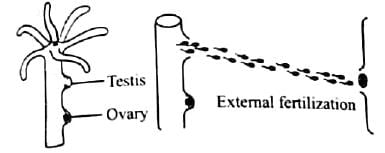
- a)Distance between testis and ovary is more.
- b)Sperms do not swim downwards.
- c)Ovary matures earlier than testis.
- d)Testis matures earlier than ovary.
Correct answer is option 'D'. Can you explain this answer?
Given figure of Hydra shows its reproductive structures and manner of fertilition

a)
Distance between testis and ovary is more.
b)
Sperms do not swim downwards.
c)
Ovary matures earlier than testis.
d)
Testis matures earlier than ovary.
|
|
Jyoti Sengupta answered |
cross-fertilisation occurs in Hydra. The testis matures earlier than the ovary. Spermatozoa released from the testis of one Hydra's swim in water with their tails and finally come into contact with the ovum of another Hydra.
Ovum lives inly for a short time after it is exposed. during this period, fertilization must take place. Thus, given figure is not showing self fertilization but cross fertilisation.
Refer the given figures and select the correct option.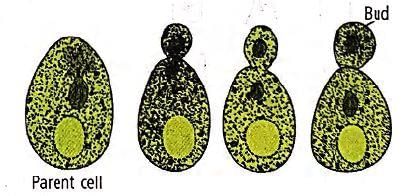
- a)It is a type of parthenogenesis.
- b)It is a type of asexual reproduction.
- c)The offsprings can also be called as clones.
- d)Both (b) and (c).
Correct answer is option 'D'. Can you explain this answer?
Refer the given figures and select the correct option.

a)
It is a type of parthenogenesis.
b)
It is a type of asexual reproduction.
c)
The offsprings can also be called as clones.
d)
Both (b) and (c).

|
Muskan Sharma answered |
The diagram shows asexual reproduction in Yeast by the process called budding. They produce identical offsprings, & identical offsprings are called clones. i.e option D is correct.
Read the following statements and select the correct option.Statement 1: Honey bees often pollinate red coloured flowers.
Statement 2: Honey bees visit flowers for pollen grains only- a)Both statements 1 and 2 are correct and statement 2 is the correct explanation of statement 1.
- b)Both statements 1 and 2 are correct but statement 2 is not the correct explanation of statement 1.
- c)Statement 1 is correct and statement 2 is incorrect.
- d)Both statements 1 and 2 are incorrect.
Correct answer is option 'D'. Can you explain this answer?
Read the following statements and select the correct option.
Statement 1: Honey bees often pollinate red coloured flowers.
Statement 2: Honey bees visit flowers for pollen grains only
Statement 2: Honey bees visit flowers for pollen grains only
a)
Both statements 1 and 2 are correct and statement 2 is the correct explanation of statement 1.
b)
Both statements 1 and 2 are correct but statement 2 is not the correct explanation of statement 1.
c)
Statement 1 is correct and statement 2 is incorrect.
d)
Both statements 1 and 2 are incorrect.
|
|
Mira Joshi answered |
Honey bees are attracted towards blue, purple-violet and yellow flowers. Bees use ultraviolet radiation for observation. Red appears black in ultraviolet radiation. Therefore, bees seldom visit red flowers. Honey bees visit flowers for nectar and pollen grains.
If a leaf cell of Agave has x chromosomes then what will be the number of chromosomes in a cell of its bulbil?
- a)2x
- b)x
- c)x/4
- d)x/2
Correct answer is option 'B'. Can you explain this answer?
If a leaf cell of Agave has x chromosomes then what will be the number of chromosomes in a cell of its bulbil?
a)
2x
b)
x
c)
x/4
d)
x/2

|
Atharva Goyal answered |
Chromosomes are the thread-like structures found in the nucleus of a cell that carry genetic information. Each species has a specific number of chromosomes in their cells, and this number is usually denoted as "x". For example, humans have 46 chromosomes, so the "x" value for humans is 46.
Agave is a genus of plants that includes species like Agave americana, commonly known as the Century Plant. When discussing the number of chromosomes in a cell, we need to consider two important factors: the type of cell and the reproductive structure.
Leaf Cell of Agave:
A leaf cell of Agave is a somatic cell, which means it is a non-reproductive cell. The somatic cells of most organisms, including plants, are diploid, meaning they contain two complete sets of chromosomes. In this case, if the leaf cell of Agave has "x" chromosomes, then the total number of chromosomes in the leaf cell would be 2x.
Bulbil Cell of Agave:
A bulbil is a small bulb-like structure that forms on the parent plant and can be used for vegetative propagation. It is a reproductive structure that can give rise to a new individual. When a bulbil forms, it undergoes a process called mitosis, which is a type of cell division that results in the production of genetically identical cells.
During mitosis, the parent cell divides into two daughter cells, each with the same number of chromosomes as the parent cell. Therefore, the number of chromosomes in a cell of the bulbil would also be "x".
Explanation of the Correct Answer:
Based on the above explanation, we can conclude that the number of chromosomes in a cell of Agave's bulbil is the same as the number of chromosomes in the leaf cell, which is denoted as "x". Therefore, the correct answer is option B, which states that the number of chromosomes in a bulbil cell is "x".
Agave is a genus of plants that includes species like Agave americana, commonly known as the Century Plant. When discussing the number of chromosomes in a cell, we need to consider two important factors: the type of cell and the reproductive structure.
Leaf Cell of Agave:
A leaf cell of Agave is a somatic cell, which means it is a non-reproductive cell. The somatic cells of most organisms, including plants, are diploid, meaning they contain two complete sets of chromosomes. In this case, if the leaf cell of Agave has "x" chromosomes, then the total number of chromosomes in the leaf cell would be 2x.
Bulbil Cell of Agave:
A bulbil is a small bulb-like structure that forms on the parent plant and can be used for vegetative propagation. It is a reproductive structure that can give rise to a new individual. When a bulbil forms, it undergoes a process called mitosis, which is a type of cell division that results in the production of genetically identical cells.
During mitosis, the parent cell divides into two daughter cells, each with the same number of chromosomes as the parent cell. Therefore, the number of chromosomes in a cell of the bulbil would also be "x".
Explanation of the Correct Answer:
Based on the above explanation, we can conclude that the number of chromosomes in a cell of Agave's bulbil is the same as the number of chromosomes in the leaf cell, which is denoted as "x". Therefore, the correct answer is option B, which states that the number of chromosomes in a bulbil cell is "x".
Clear cut vegetative, reproductive and senescent phases cannot be observed in- a)annual plants
- b)perennial plants
- c) biennial plants
- d)ephemeral plants
Correct answer is option 'B'. Can you explain this answer?
Clear cut vegetative, reproductive and senescent phases cannot be observed in
a)
annual plants
b)
perennial plants
c)
biennial plants
d)
ephemeral plants
|
|
Mira Joshi answered |
Perennial plants live for a few to several hundred years, hence vegetative, reproductive and senescent phases cannot be observed clearly
During binary fission in Amoeba which of the following organelles is duplicated?- a)Plasma membrane
- b)Nucleus
- c)Contractile vacuole
- d)All of these
Correct answer is option 'B'. Can you explain this answer?
During binary fission in Amoeba which of the following organelles is duplicated?
a)
Plasma membrane
b)
Nucleus
c)
Contractile vacuole
d)
All of these
|
|
Ajay Yadav answered |
In Amoeba, simple (irregular) binary fission occurs and nucleus is duplicated during this process. Binary fission involves mitosis and the resultant offsprings are genetically identical to the parent and to each other.
Meiosis does not occur in- a)asexually reproducing diploid individuals
- b)sexually reproducing haploid individuals
- c)sexually reproducing diploid individuals
- d)all of these
Correct answer is option 'A'. Can you explain this answer?
Meiosis does not occur in
a)
asexually reproducing diploid individuals
b)
sexually reproducing haploid individuals
c)
sexually reproducing diploid individuals
d)
all of these
|
|
Mira Joshi answered |
Meiosis does not occur in asexually reproducing individuals. There is only mitotic cell division and multiplication occurs rapidly. On the other hand, sexual reproduction involves both meiosis and mitosis.
Organisms reproducing throughout the year are called ______ breeders e.g., ________, and those who show recurring sexual activity are called __________ breeders e.g., _________.- a)Continuous, sparrow, seasonal, hen
- b)Seasonal, lizard, continuous, hen
- c)Continuous, man, seasonal, tiger
- d)Seasonal, hen, continuous, tiger
Correct answer is option 'C'. Can you explain this answer?
Organisms reproducing throughout the year are called ______ breeders e.g., ________, and those who show recurring sexual activity are called __________ breeders e.g., _________.
a)
Continuous, sparrow, seasonal, hen
b)
Seasonal, lizard, continuous, hen
c)
Continuous, man, seasonal, tiger
d)
Seasonal, hen, continuous, tiger
|
|
Mira Joshi answered |
Continuous breeders continue to breed throughout their sexual maturity. Examples are honey bee, rabbit, mice. cattle, man, etc. Seasonal breeders reproduce at particular period of the year such as frog, lizard, most birds, deer, tiger, etc.
If a leaf cell of Agave has x chromosomes then what will be the number of chromosomes in a cell of its bulbil? - a)2x
- b)x/2
- c)x/4
- d)x
Correct answer is option 'D'. Can you explain this answer?
If a leaf cell of Agave has x chromosomes then what will be the number of chromosomes in a cell of its bulbil?
a)
2x
b)
x/2
c)
x/4
d)
x
|
|
Mira Joshi answered |
In Agave, bulbils are modified floral buds that develop on the flowering axis, so chromosome number in a cell of bulbil will be equal to that of leaf cell of Agave, i.e., n = x
Select the incorrect statement about external fertilization.
- a)Organisms showing external fertilisation produce a large number of male gametes only.
- b)External fertilisation is very uncertain and requires synchony between release of male and female gametes.
- c)It is replaced by internal fertilisation in higher organisms as it wastes energy and requires external medium like water.
- d)It occurs in most of the fishes and amphibians.
Correct answer is option 'A'. Can you explain this answer?
Select the incorrect statement about external fertilization.
a)
Organisms showing external fertilisation produce a large number of male gametes only.
b)
External fertilisation is very uncertain and requires synchony between release of male and female gametes.
c)
It is replaced by internal fertilisation in higher organisms as it wastes energy and requires external medium like water.
d)
It occurs in most of the fishes and amphibians.
|
|
Ajay Yadav answered |
The incorrect statement about external fertilization is:
- Organisms showing external fertilization produce a large number of male gametes only.
This statement is incorrect because in external fertilization, both male and female gametes are released into the external medium, such as water, where fertilization takes place. Therefore, statement 1 is incorrect.
External fertilization is a reproductive strategy where fertilization takes place outside the body of the organism, usually in a water medium. It is true that external fertilization requires synchronization between the release of male and female gametes, and is more uncertain compared to internal fertilization, which occurs inside the body of the organism.
It is also true that external fertilization is common in many fish and amphibian species, but it is not always replaced by internal fertilization in higher organisms. Some higher organisms, such as some reptiles, birds, and monotremes (egg-laying mammals), still use external fertilization as their primary mode of reproduction.
Therefore, the correct answer is option 1: Organisms showing external fertilization produce a large number of male gametes only.
Which of the following is a dioecious organism?- a)

- b)

- c)

- d)

Correct answer is option 'D'. Can you explain this answer?
Which of the following is a dioecious organism?
a)

b)

c)

d)

|
|
Mira Joshi answered |
Organism shown in figure (d) is Nereis. It is unisexual or dioecious and its reproductive phase is called ‘heteronereis’ Fertilization occurs in sea water.
Figure P represents the reproductive organs of Chara plant and figure Q represents the reproductive organs of earthworm. Select the optikon which correctly identifies male reproductive organs of the two organisms.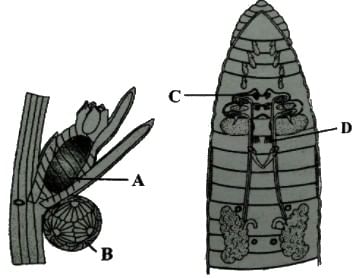
- a)A and D
- b)B and C
- c)A and C
- d)B and D
Correct answer is option 'B'. Can you explain this answer?
Figure P represents the reproductive organs of Chara plant and figure Q represents the reproductive organs of earthworm. Select the optikon which correctly identifies male reproductive organs of the two organisms.

a)
A and D
b)
B and C
c)
A and C
d)
B and D
|
|
Vivek Patel answered |
Male sex organ in Chara is round in structure, called antheridium (B). It lies below the ovate shaped female sex organ called oogonium. Earthworm is bisexual or hermaphrodite organism. (C) show two pair of testis sacs, situated in the tenth and eleventh segments.
It is observed that simple organisms like algae and fungi normally reproduce asexually but before the onset of adverse conditions they shift to sexual reproduction. It is so because sexual reproduction- a)saves time
- b)is rapid
- c)produces variations
- d)all of these.
Correct answer is option 'C'. Can you explain this answer?
It is observed that simple organisms like algae and fungi normally reproduce asexually but before the onset of adverse conditions they shift to sexual reproduction. It is so because sexual reproduction
a)
saves time
b)
is rapid
c)
produces variations
d)
all of these.
|
|
Mira Joshi answered |
During favourable conditions, simple organisms like algae and funai multiply asexually but during unfavourable conditions gametes are formed. The gametes fuse to form zygotes which often develop a thick wall to become zygospores. The latter are dispersed. Under favourable zygospore germinates to form new organisms. Since fusion of gametes from different parents occur during sexual reproduction, hence genetic recombination takes place causing variations. Variations, being a major factor of natural selection, play an important role in evolution.
Senescent phase of an organism's life span can be recognized- a)slow metabolism
- b)cessation of reproduction
- c)decreased immunity
- d)all of these.
Correct answer is option 'D'. Can you explain this answer?
Senescent phase of an organism's life span can be recognized
a)
slow metabolism
b)
cessation of reproduction
c)
decreased immunity
d)
all of these.
|
|
Mira Joshi answered |
The terminal irreversible stage of ageing is called senescence. This is the last phase of life span, that ultimately leads to death. In both plants and animals, hormones are responsible for the change over from one phase to another This phase can be recognised by slow metabolism, cessation of reproduction and decreased immunity.
Read the following statements and select the correct option.
Statement 1: Many plants are propagated vegetatively even though they bear seeds.
Statement 2: Sweet potatoes multiply vegetatively by root tubers.- a)Both statements 1 and 2 are correct and statement 2 is the correct explanation of statement 1.
- b)Both statements 1 and 2 are correct but statement 2 is not the correct explanation of statement 1.
- c)Statement 1 is correct and statement 2 is incorrect.
- d)Both statements 1 and 2 are incorrect.
Correct answer is option 'B'. Can you explain this answer?
Read the following statements and select the correct option.
Statement 1: Many plants are propagated vegetatively even though they bear seeds.
Statement 2: Sweet potatoes multiply vegetatively by root tubers.
Statement 1: Many plants are propagated vegetatively even though they bear seeds.
Statement 2: Sweet potatoes multiply vegetatively by root tubers.
a)
Both statements 1 and 2 are correct and statement 2 is the correct explanation of statement 1.
b)
Both statements 1 and 2 are correct but statement 2 is not the correct explanation of statement 1.
c)
Statement 1 is correct and statement 2 is incorrect.
d)
Both statements 1 and 2 are incorrect.
|
|
Vivek Patel answered |
Vegetative propagation is the formation of new plants from vegetative units such as buds, tubers, rhizomes, etc. This method produces a large number of population of clones in short time. It preserves purity, resistance and good qualities of race/variety indefinitely. Fleshy roots (root tubers) which develop adventitious buds also take part in vegetative propagation.
Example: Sweet potato.
Example: Sweet potato.
Which of the following is not used for vegetative propagation?- a)Bud
- b)Bulbil
- c)Turion
- d)Antherozoid
Correct answer is option 'D'. Can you explain this answer?
Which of the following is not used for vegetative propagation?
a)
Bud
b)
Bulbil
c)
Turion
d)
Antherozoid
|
|
Vivek Patel answered |
In sexually reproducing organisms, the male gamele is called the antherozoid or sperm and the known as the egg or ovum. They are not used for vegitative propagation.
Refer the given figures which show three different types of fission. Select the option which correctly matches them with the organism in which they occur.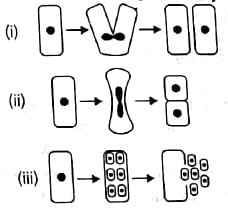
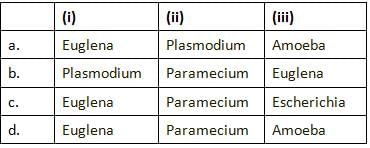
- a)a
- b)b
- c)c
- d)d
Correct answer is option 'D'. Can you explain this answer?
Refer the given figures which show three different types of fission. Select the option which correctly matches them with the organism in which they occur.


a)
a
b)
b
c)
c
d)
d
|
|
Vivek Patel answered |
Figure (i) shows longitudinal binary fission in Euglena, (ii) shows transverse binary fission in Paramecium and (iii) shows multiple fission in uncysted Amoeba.
____________ is a life process that is not essential for an individual's survival but for survival of the species.- a)Growth
- b)Reproduction
- c)Respiration
- d)Nutrition
Correct answer is option 'B'. Can you explain this answer?
____________ is a life process that is not essential for an individual's survival but for survival of the species.
a)
Growth
b)
Reproduction
c)
Respiration
d)
Nutrition
|
|
Vivek Patel answered |
Reproduction is a biological process in which an organism produces young ones (offspring) of the same species. It is one of the most important characteristics of the living organisms. Reproduction is essential for the survival of species but not for the survival of individuals.
Following table summarizes the differences between self fertilization and cross-fertilization. Pick out the wrong difference.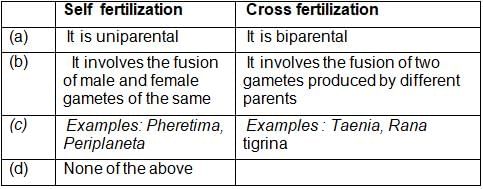
- a)a
- b)b
- c)c
- d)d
Correct answer is option 'C'. Can you explain this answer?
Following table summarizes the differences between self fertilization and cross-fertilization. Pick out the wrong difference.

a)
a
b)
b
c)
c
d)
d
|
|
Mira Joshi answered |
Self-fertilization occurs in Taenia, while cross fertilization occurs in Pheretima, Periplaneta and Rana tigrina.
Select the mismatched pair of organism and their mode multiplication.
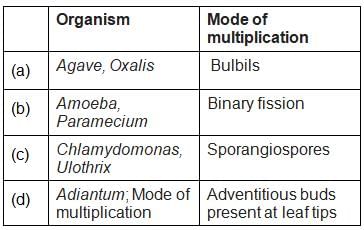
- a)a
- b)b
- c)c
- d)d
Correct answer is option 'C'. Can you explain this answer?
Select the mismatched pair of organism and their mode multiplication.

a)
a
b)
b
c)
c
d)
d
|
|
Vivek Patel answered |
They are non-motile spores produced inside the sporangia. They are generally dispersed by wind and germinate to produce new mycelium.(e.g., Rhizopus, Mucor. etc.) In Chlamydononas and Ulothrix. are formed.
Which of the following cannot serve as a vegetative propagule?- a)A piece of potato tuber with eyes
- b)A middle piece of sugarcane internode
- c)A piece of ginger rhizome
- d)A marginal piece of Bryophyllum leaf
Correct answer is option 'B'. Can you explain this answer?
Which of the following cannot serve as a vegetative propagule?
a)
A piece of potato tuber with eyes
b)
A middle piece of sugarcane internode
c)
A piece of ginger rhizome
d)
A marginal piece of Bryophyllum leaf
|
|
Vivek Patel answered |
New buds arise from node, not from internode, hence a middle piece of sugarcane (internode) cannot serve as a vegetative propagule.
Which of the following is an incorrect combination of organism with its chromosome number in meiocyte and in gamete?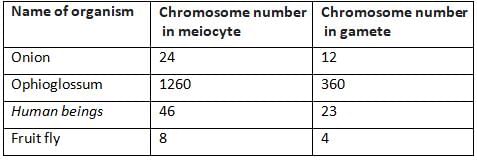
- a)a
- b)b
- c)c
- d)d
Correct answer is option 'A'. Can you explain this answer?
Which of the following is an incorrect combination of organism with its chromosome number in meiocyte and in gamete?

a)
a
b)
b
c)
c
d)
d
|
|
Mira Joshi answered |
Chromosome number in meiocyte (2n) of onion cell is 32, while chromosome number in gamete (n) is 16.
Which of the following organisms has the highest number of chromosomes? - a)Housefly
- b)Butterfly
- c)Ophioglossum
- d)Onion
Correct answer is option 'C'. Can you explain this answer?
Which of the following organisms has the highest number of chromosomes?
a)
Housefly
b)
Butterfly
c)
Ophioglossum
d)
Onion
|
|
Mira Joshi answered |
Ophioglossum is a fern having highest number of chromosomes. Chromosomes number in meiocyte (2n) = 1260. Chromosome number in gamete (n) = 630.
The growth phase of an organism before attaining sexualmaturity is referred to as- a)juvenile phase
- b)vegetative phase
- c)both (a) and (b)
- d)none of these.
Correct answer is option 'C'. Can you explain this answer?
The growth phase of an organism before attaining sexualmaturity is referred to as
a)
juvenile phase
b)
vegetative phase
c)
both (a) and (b)
d)
none of these.
|
|
Mira Joshi answered |
Juvenile phase is pre-reproductive phase in life cycle of an individual. It is the period of growth between the birth of an individual upto reproductive maturity. Juvenile phase is known as vegetative phase in plants. This phase is of different durations in different organisms.
Which of the following options correctly identities artificial and natural methods of vegetative propagation?
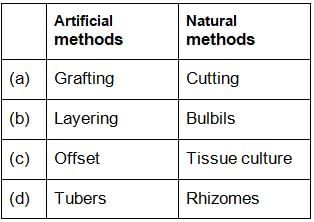
- a)a
- b)b
- c)c
- d)d
Correct answer is option 'B'. Can you explain this answer?
Which of the following options correctly identities artificial and natural methods of vegetative propagation?


a)
a
b)
b
c)
c
d)
d
|
|
Vivek Patel answered |
Layering is a type of horticultural or artificial method of vegetative propagation in which adventitious roots are induced to develop on a soft stem while it is still attached to the plant. Bulbils are multicellular fleshy buds that take part in natural vegetative propagation.
Example: Oxalis, Agave, pineapple.
Example: Oxalis, Agave, pineapple.
Read the following statements about the reproductive cycles in mammals and select the correct ones.
(i) Oestrous cycle occurs in primate mammals
(ii) in species with oestrous cycle females are generally sexually active during estrous phase
iii) Both the cycles show monthly recurrence. - a)(i) and (ii)
- b)(ii) and (iii)
- c)(ii) only
- d)(i) (ii) and (iii)
Correct answer is option 'C'. Can you explain this answer?
Read the following statements about the reproductive cycles in mammals and select the correct ones.
(i) Oestrous cycle occurs in primate mammals
(ii) in species with oestrous cycle females are generally sexually active during estrous phase
iii) Both the cycles show monthly recurrence.
(i) Oestrous cycle occurs in primate mammals
(ii) in species with oestrous cycle females are generally sexually active during estrous phase
iii) Both the cycles show monthly recurrence.
a)
(i) and (ii)
b)
(ii) and (iii)
c)
(ii) only
d)
(i) (ii) and (iii)
|
|
Mira Joshi answered |
Oestrous cycle occur in non-primates such as cows, dogs, etc. Menstrual cycle occurs in primates only. Menstrual shows monthly recurrence but oestrous cycle does not.
'Clones' are individuals that have exactly the same- a)lifespan
- b)physiology
- c)growth rate
- d)genetic makeup
Correct answer is option 'D'. Can you explain this answer?
'Clones' are individuals that have exactly the same
a)
lifespan
b)
physiology
c)
growth rate
d)
genetic makeup
|
|
Vivek Patel answered |
Clone is population of genetically identical organisms or cells derived from a orignal single organismor cell by asexual reproduction.
In which of the following plants, vegetative propagation occurs by adventitious buds?- a)
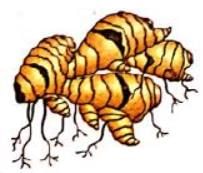
- b)
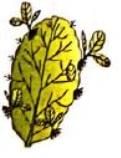
- c)
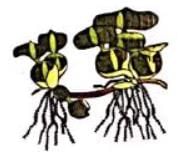
- d)None of these
Correct answer is option 'B'. Can you explain this answer?
In which of the following plants, vegetative propagation occurs by adventitious buds?
a)

b)

c)

d)
None of these
|
|
Ajay Yadav answered |
Bryophyllum (figure b) propogates vegetatively by adventitious leafbuds. Leaves of Bryophyllum carry on photosynthesis, their usual function, but in addition they have the capacity to produce one or more plants from the notches in their margins. It is also observed in Kalanchoe.
March Column-l with Column-ll and select the correct options from the codes given below.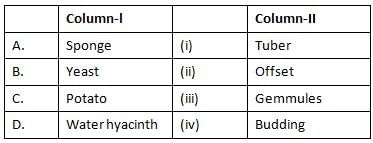 Codes:a. A-(iv), B- (i), C-(ii), D-(iii)b. A-(iii), B- (i), C-(iv), D-(ii)c. A-(iii), B- (iv), C-(i), D-(ii)d. A-(iv), B- (ii), C-(i), D-(iii)
Codes:a. A-(iv), B- (i), C-(ii), D-(iii)b. A-(iii), B- (i), C-(iv), D-(ii)c. A-(iii), B- (iv), C-(i), D-(ii)d. A-(iv), B- (ii), C-(i), D-(iii)- a)a
- b)b
- c)c
- d)d
Correct answer is option 'C'. Can you explain this answer?
March Column-l with Column-ll and select the correct options from the codes given below.

Codes:
a. A-(iv), B- (i), C-(ii), D-(iii)
b. A-(iii), B- (i), C-(iv), D-(ii)
c. A-(iii), B- (iv), C-(i), D-(ii)
d. A-(iv), B- (ii), C-(i), D-(iii)
a)
a
b)
b
c)
c
d)
d
|
|
Ajay Yadav answered |
A. A sponge produces a tough coated dormant cluster of embryonic cells for development in more favourable conditions called Gemmules.
B. Yeast is a unicellular fungus. It reproduces asexually by the formation of spores. During the process of budding in yeast, the parent cell develops a small protuberance which grows in size.
C. Potato: Each eye of potato tuber is a bud which grows into a new potato plant when planted with a portion of the swollen tuber.
D. Offsets are one internode long runners which develop tuft of leaves at the apex. Example: Water hyacinth.
B. Yeast is a unicellular fungus. It reproduces asexually by the formation of spores. During the process of budding in yeast, the parent cell develops a small protuberance which grows in size.
C. Potato: Each eye of potato tuber is a bud which grows into a new potato plant when planted with a portion of the swollen tuber.
D. Offsets are one internode long runners which develop tuft of leaves at the apex. Example: Water hyacinth.
Staminate flowers produce - a)eggs
- b)antherozoids
- c)fruits
- d)all of these
Correct answer is option 'B'. Can you explain this answer?
Staminate flowers produce
a)
eggs
b)
antherozoids
c)
fruits
d)
all of these
|
|
Mira Joshi answered |
Staminate flowers are those which have only male propagative organs, or stamens, or have infertile female organs. Staminate flowers produce only pollen (antherozoids) and are not capable of producing fruit.
Refer the given figures and select the correct option.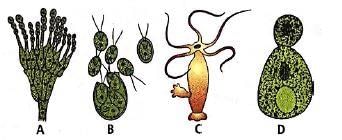
- a)C and D reproduce by budding that includes nuclear division only.
- b)All of these reproduce by the asexual mode of reproduction.
- c)B represents multiple fission in an alga.
- d)A shows spore formation in a moneran.
Correct answer is option 'B'. Can you explain this answer?
Refer the given figures and select the correct option.

a)
C and D reproduce by budding that includes nuclear division only.
b)
All of these reproduce by the asexual mode of reproduction.
c)
B represents multiple fission in an alga.
d)
A shows spore formation in a moneran.
|
|
Jyoti Sengupta answered |
All the organisms shown in the figure reproduce asexually. (A) is Penicillium in which non-motile conidia are produced singly or in chains. Organism (B) is Chlamydomonas in which reproduction occurs by zoospores. In Hydra (C) and yeast (D), asexual reproduction takes place by budding
If a fungal thallus has both male and female reproductive structure, it will be called- a)Heterothallic
- b)Homothallic
- c)Dioecious
- d)Monoecious
Correct answer is option 'B'. Can you explain this answer?
If a fungal thallus has both male and female reproductive structure, it will be called
a)
Heterothallic
b)
Homothallic
c)
Dioecious
d)
Monoecious
|
|
Mira Joshi answered |
Depending upon the compatibility in sexual reproduction, fungi are of two types - homothallic and heterothallic. In homothallic forms, fusion occurs between genetically similar types. Fusion involves the union of cytoplasms as well as nuclei. In heterothallic forms, fusion occurs between gametes belonging to different parents.
Chapter doubts & questions for Reproduction in Organisms - Biology Class 12 2025 is part of NEET exam preparation. The chapters have been prepared according to the NEET exam syllabus. The Chapter doubts & questions, notes, tests & MCQs are made for NEET 2025 Exam. Find important definitions, questions, notes, meanings, examples, exercises, MCQs and online tests here.
Chapter doubts & questions of Reproduction in Organisms - Biology Class 12 in English & Hindi are available as part of NEET exam.
Download more important topics, notes, lectures and mock test series for NEET Exam by signing up for free.

Contact Support
Our team is online on weekdays between 10 AM - 7 PM
Typical reply within 3 hours
|
Free Exam Preparation
at your Fingertips!
Access Free Study Material - Test Series, Structured Courses, Free Videos & Study Notes and Prepare for Your Exam With Ease

 Join the 10M+ students on EduRev
Join the 10M+ students on EduRev
|

|
Create your account for free
OR
Forgot Password
OR
Signup to see your scores
go up within 7 days!
Access 1000+ FREE Docs, Videos and Tests
Takes less than 10 seconds to signup









